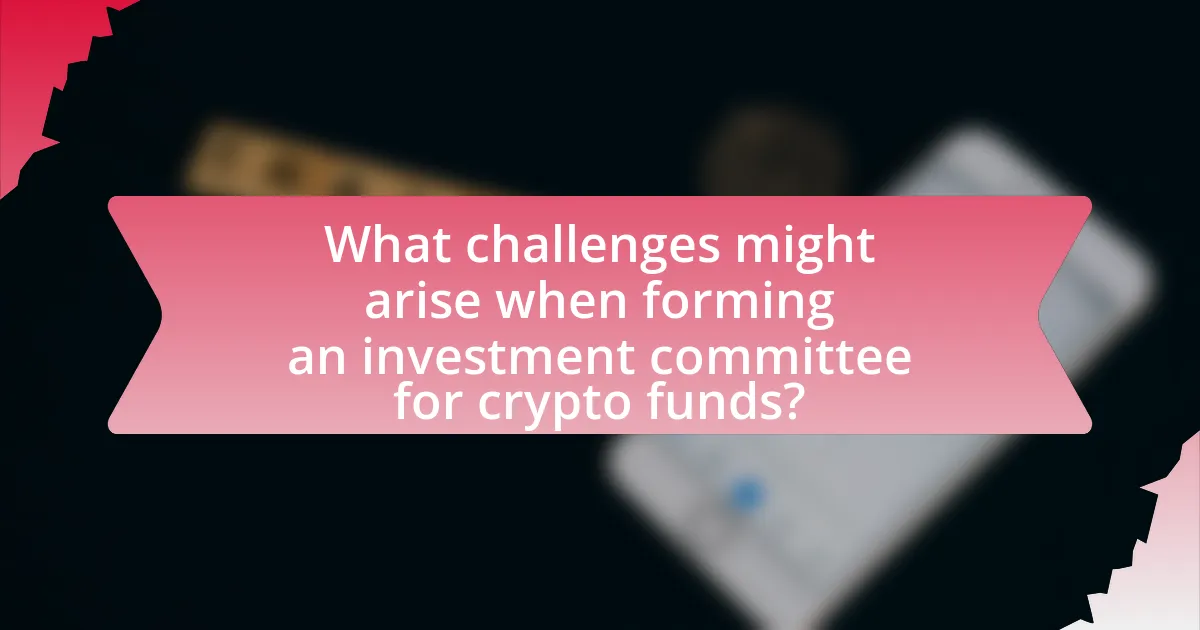An effective investment committee for crypto funds is essential for making informed decisions in the volatile cryptocurrency market. This article outlines the structure, roles, and responsibilities of such committees, emphasizing the importance of diverse expertise in finance, technology, and regulatory compliance. It discusses how these committees function, the risks they help mitigate, and the best practices for ongoing effectiveness, including continuous education and performance evaluation metrics. Additionally, it highlights the significance of transparency and adaptability in decision-making processes to navigate the rapidly changing landscape of crypto investments.

What is an Effective Investment Committee for Crypto Funds?
An effective investment committee for crypto funds is a group of experienced professionals responsible for making informed investment decisions in the cryptocurrency market. This committee typically includes members with diverse expertise in finance, technology, and regulatory environments, ensuring a comprehensive understanding of the unique risks and opportunities associated with crypto assets.
The effectiveness of such a committee is often measured by its ability to conduct thorough due diligence, assess market trends, and implement robust risk management strategies. For instance, a study by the CFA Institute highlights that investment committees with a diverse skill set are better equipped to navigate the complexities of emerging markets, including cryptocurrencies. This diversity allows for more balanced decision-making and enhances the committee’s overall performance in managing crypto fund investments.
How does an investment committee function within crypto funds?
An investment committee within crypto funds functions as a decision-making body that evaluates and approves investment strategies and asset allocations. This committee typically comprises experienced professionals with expertise in finance, blockchain technology, and market analysis, ensuring informed decisions are made regarding cryptocurrency investments. The committee assesses potential investments based on rigorous criteria, including risk assessment, market trends, and alignment with the fund’s objectives. By conducting thorough due diligence and leveraging collective knowledge, the investment committee aims to optimize returns while managing risks associated with the volatile nature of cryptocurrencies.
What roles and responsibilities are typically assigned to committee members?
Committee members are typically assigned roles and responsibilities that include decision-making, oversight, and strategic planning. These members are responsible for evaluating investment opportunities, ensuring compliance with regulations, and monitoring the performance of the fund. Additionally, they contribute to the development of investment policies and guidelines, facilitate discussions on market trends, and provide expertise in specific areas relevant to cryptocurrency investments. Their collective input is crucial for making informed decisions that align with the fund’s objectives and risk tolerance.
How does the structure of the committee influence decision-making?
The structure of the committee significantly influences decision-making by determining the roles, responsibilities, and dynamics among members. A well-defined structure, such as having designated chairs, subcommittees, or specific expertise areas, facilitates efficient communication and accountability, leading to more informed and timely decisions. For instance, research indicates that committees with diverse expertise are better at evaluating complex investment opportunities, as they can draw on a wider range of perspectives and knowledge. This diversity enhances critical thinking and reduces the likelihood of groupthink, ultimately improving the quality of decisions made regarding crypto fund investments.
Why is an investment committee crucial for crypto funds?
An investment committee is crucial for crypto funds because it ensures informed decision-making and risk management. The volatile nature of cryptocurrencies requires a structured approach to evaluate investment opportunities, assess risks, and establish strategic objectives. Investment committees typically consist of experienced professionals who bring diverse expertise, enabling them to analyze market trends, regulatory changes, and technological advancements effectively. This collective knowledge helps in making sound investment choices, ultimately enhancing the fund’s performance and safeguarding investors’ capital.
What risks does an investment committee help mitigate in crypto investments?
An investment committee helps mitigate several risks in crypto investments, including market volatility, regulatory uncertainty, and security threats. By conducting thorough due diligence and establishing investment criteria, the committee can assess the potential for price fluctuations and make informed decisions to minimize losses. Additionally, the committee can stay updated on regulatory changes, ensuring compliance and reducing the risk of legal repercussions. Security risks, such as hacking and fraud, can also be addressed through the implementation of robust security protocols and risk management strategies. These proactive measures collectively enhance the overall stability and security of crypto investments.
How does a committee enhance the credibility of a crypto fund?
A committee enhances the credibility of a crypto fund by providing diverse expertise and oversight, which fosters trust among investors. The presence of professionals with backgrounds in finance, technology, and regulatory compliance ensures that investment decisions are well-informed and strategically sound. This multidisciplinary approach reduces the risk of poor decision-making, as evidenced by studies showing that investment committees can improve performance by up to 20% compared to individual decision-makers. Furthermore, a committee’s structured governance and accountability mechanisms promote transparency, which is crucial in the often volatile and opaque crypto market, thereby increasing investor confidence.

What are the key components of building an effective investment committee?
The key components of building an effective investment committee include diverse expertise, clear governance structures, defined roles and responsibilities, and a robust decision-making process. Diverse expertise ensures that the committee encompasses various perspectives, including finance, technology, and regulatory knowledge, which is crucial for navigating the complexities of crypto investments. Clear governance structures establish accountability and transparency, allowing for effective oversight and compliance with regulations. Defined roles and responsibilities clarify expectations and enhance collaboration among members, ensuring that each individual contributes effectively to the committee’s objectives. A robust decision-making process, often supported by data-driven analysis and risk assessment, enables the committee to make informed investment choices that align with the fund’s goals. These components collectively enhance the committee’s ability to manage risks and capitalize on opportunities in the dynamic crypto market.
How do you select the right members for the committee?
To select the right members for the committee, identify individuals with diverse expertise in cryptocurrency, finance, and risk management. This diversity ensures a comprehensive understanding of the market and informed decision-making. Research indicates that committees with varied backgrounds outperform homogeneous groups, as they bring different perspectives and reduce groupthink, which is crucial in the volatile crypto landscape. Additionally, consider candidates with proven track records in investment strategies and a strong network within the crypto community, as these attributes enhance the committee’s credibility and effectiveness.
What qualifications and experience should members possess?
Members of an effective investment committee for crypto funds should possess qualifications in finance, investment management, and blockchain technology, along with relevant experience in these fields. Specifically, members should have a minimum of a bachelor’s degree in finance, economics, or a related discipline, and ideally hold advanced degrees such as an MBA or a master’s in finance.
Experience should include a track record of managing investment portfolios, familiarity with cryptocurrency markets, and understanding of regulatory frameworks. For instance, having worked in investment banking, asset management, or as a financial analyst can provide the necessary skills for evaluating crypto assets. Additionally, practical experience in blockchain technology or previous involvement in crypto projects enhances a member’s ability to make informed decisions.
These qualifications and experiences ensure that committee members can effectively assess risks, identify opportunities, and contribute to strategic decision-making in the rapidly evolving landscape of cryptocurrency investments.
How can diversity in expertise benefit the committee’s performance?
Diversity in expertise enhances the committee’s performance by fostering a broader range of perspectives and solutions. When committee members possess varied backgrounds in finance, technology, law, and market analysis, they can approach problems from multiple angles, leading to more innovative and effective decision-making. Research indicates that diverse teams are 35% more likely to outperform their homogeneous counterparts, as they can better identify risks and opportunities in complex environments, such as the rapidly evolving crypto market. This diversity not only improves problem-solving capabilities but also enhances the committee’s ability to adapt to changing market conditions, ultimately leading to more informed investment strategies.
What processes should be established for effective committee operations?
Effective committee operations require the establishment of clear communication protocols, defined roles and responsibilities, and structured decision-making processes. Clear communication protocols ensure that all members are informed and engaged, which is critical for collaboration and transparency. Defined roles and responsibilities help to clarify expectations and accountability among committee members, reducing overlap and confusion. Structured decision-making processes, such as using a consensus model or majority voting, facilitate timely and effective resolutions to issues. These processes are supported by research indicating that well-defined structures enhance group performance and decision quality, particularly in investment contexts where clarity and efficiency are paramount.
How often should the committee meet to ensure effective oversight?
The committee should meet at least quarterly to ensure effective oversight. Regular quarterly meetings allow the committee to review investment performance, assess risks, and make timely decisions based on market conditions. Research indicates that frequent engagement, such as quarterly meetings, enhances oversight effectiveness by providing opportunities for real-time adjustments and strategic discussions, which are crucial in the rapidly changing landscape of crypto investments.
What decision-making frameworks can be implemented?
Several decision-making frameworks can be implemented to enhance the effectiveness of an investment committee for crypto funds. The Rational Decision-Making Model is one such framework, which involves identifying the problem, gathering information, evaluating alternatives, and making a decision based on logical reasoning. Another framework is the Consensus Decision-Making Model, where all members of the committee collaborate to reach an agreement, ensuring that diverse perspectives are considered. Additionally, the SWOT Analysis framework can be utilized to assess the strengths, weaknesses, opportunities, and threats related to investment options, providing a comprehensive view for informed decision-making. These frameworks are supported by research indicating that structured decision-making processes lead to better outcomes in investment contexts, as they reduce biases and enhance collaboration among committee members.

What challenges might arise when forming an investment committee for crypto funds?
Forming an investment committee for crypto funds presents several challenges, including regulatory uncertainty, lack of experienced professionals, and the volatility of the cryptocurrency market. Regulatory uncertainty arises because the legal framework surrounding cryptocurrencies is still evolving, making it difficult for committees to navigate compliance issues effectively. The lack of experienced professionals is significant, as many traditional finance experts may not have the necessary knowledge or experience in the rapidly changing crypto landscape. Additionally, the inherent volatility of cryptocurrencies can complicate investment strategies, leading to potential conflicts among committee members regarding risk tolerance and investment approaches. These challenges necessitate careful consideration and strategic planning when establishing an investment committee for crypto funds.
How can conflicts of interest be managed within the committee?
Conflicts of interest within the committee can be managed by implementing a robust conflict of interest policy that requires members to disclose any potential conflicts before discussions or decisions. This policy should include clear guidelines on how to handle disclosed conflicts, such as recusal from relevant discussions or votes. Additionally, regular training on ethical standards and transparency can reinforce the importance of managing conflicts effectively. Research indicates that committees with established conflict management protocols are more likely to maintain integrity and trust, which is crucial for effective decision-making in investment contexts.
What strategies can be employed to ensure transparency in decision-making?
To ensure transparency in decision-making, investment committees can implement strategies such as establishing clear communication protocols, documenting decisions, and involving diverse stakeholders. Clear communication protocols facilitate open discussions and ensure that all members understand the rationale behind decisions. Documenting decisions creates a record that can be reviewed and audited, enhancing accountability. Involving diverse stakeholders brings multiple perspectives, which can lead to more informed and transparent outcomes. Research indicates that organizations with transparent decision-making processes tend to have higher levels of trust and engagement among stakeholders, as seen in studies by the Harvard Business Review, which highlight the correlation between transparency and organizational effectiveness.
How can the committee adapt to the rapidly changing crypto landscape?
The committee can adapt to the rapidly changing crypto landscape by implementing continuous education and agile decision-making processes. Continuous education ensures that committee members stay informed about emerging trends, regulatory changes, and technological advancements in the crypto space. For instance, attending industry conferences and participating in webinars can enhance their knowledge base. Agile decision-making allows the committee to respond quickly to market fluctuations and new opportunities, which is crucial given the volatility of cryptocurrencies. Research indicates that investment committees that regularly review their strategies and adjust their portfolios based on real-time data outperform those that do not. This adaptability is essential for maintaining a competitive edge in the dynamic crypto market.
What best practices should be followed for ongoing committee effectiveness?
To ensure ongoing committee effectiveness, it is essential to establish clear roles and responsibilities for each member. This clarity enhances accountability and ensures that all members understand their contributions to the committee’s objectives. Regularly scheduled meetings, ideally monthly, facilitate consistent communication and allow for timely decision-making, which is crucial in the fast-paced environment of crypto investments. Additionally, implementing a structured agenda for each meeting helps maintain focus and ensures that all relevant topics are addressed efficiently.
Furthermore, fostering an environment of open communication encourages members to share insights and concerns, which can lead to more informed decision-making. Utilizing performance metrics to evaluate the committee’s effectiveness periodically allows for adjustments and improvements based on data-driven insights. Research indicates that committees that engage in self-assessment and feedback mechanisms tend to perform better, as they can adapt to changing circumstances and member dynamics.
In summary, best practices for ongoing committee effectiveness include defining roles, scheduling regular meetings, maintaining structured agendas, promoting open communication, and utilizing performance metrics for evaluation.
How can continuous education and training be integrated for committee members?
Continuous education and training for committee members can be integrated through structured programs that include workshops, online courses, and regular seminars focused on the latest trends in cryptocurrency and investment strategies. These programs should be tailored to the specific needs of the committee, ensuring that members stay updated on regulatory changes, market dynamics, and technological advancements. For instance, organizations like the CFA Institute offer resources and certifications that can enhance the knowledge base of committee members, thereby improving decision-making processes. Regular assessments and feedback mechanisms can also be implemented to evaluate the effectiveness of the training and ensure that it meets the evolving demands of the crypto investment landscape.
What metrics should be used to evaluate the committee’s performance?
The metrics used to evaluate the committee’s performance should include investment returns, decision-making efficiency, and adherence to investment strategy. Investment returns measure the profitability of the committee’s decisions, typically assessed against benchmarks like market indices or peer funds. Decision-making efficiency evaluates the speed and quality of the committee’s decisions, often analyzed through the time taken to reach conclusions and the outcomes of those decisions. Adherence to investment strategy assesses how closely the committee follows its established guidelines and objectives, which can be quantified by tracking deviations from the strategy and their impact on performance. These metrics provide a comprehensive view of the committee’s effectiveness in managing investments within crypto funds.
What practical tips can enhance the effectiveness of an investment committee for crypto funds?
To enhance the effectiveness of an investment committee for crypto funds, establish clear roles and responsibilities for each member. This clarity ensures that all members understand their contributions and decision-making authority, which is crucial in the fast-paced crypto environment. Additionally, implementing regular training sessions on market trends and regulatory changes can keep the committee informed and agile, allowing for timely and informed investment decisions. Research indicates that committees with diverse expertise and backgrounds are more effective, as they bring varied perspectives that can lead to better risk assessment and innovative strategies. Furthermore, utilizing data analytics tools can provide insights into market movements and portfolio performance, enabling the committee to make data-driven decisions.















